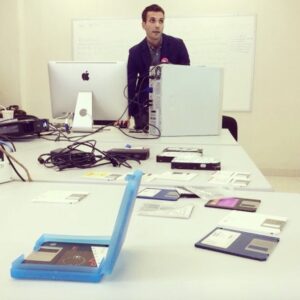PART 1
Ben is a NYC based media archaeologist, archivist and conservator of born-digital and computer based works of contemporary art. Currently, he is the Associate Media Conservator at the Museum of Modern Art (MoMA). In this role, he develops strategies and policy that contribute to the preservation of the museum’s digital collections. He has also worked with the Whitney Museum, Cory Arcangel, JODI, Rhizome just to name a few.
We are thrilled that Ben has joined us as an Advisor and is working with us on a key part of the Niio platform – – digital preservation.

What led to your interest in digital preservation?
Early in my graduate work, I learned about digital preservation. Until that time, I had never stopped to consider who was ensuring that contemporary (read: digital) cultural heritage would be around in 100 years. At that moment, it struck me as such an incredibly fascinating problem and I knew that I wanted to see how I could contribute to answering some of those questions.
Why do you think digital preservation is so important for artists, collectors and museums?
You cannot simply put something digital on a shelf and expect it to be readable in ten years. Lack of active and systematic stewardship equates to benign neglect.
Artists working with digital materials must actively consider preservation or run the risk of their work being inaccessible some day in the future when an interested collector comes knocking.
For museums or collectors it is a matter of responsibility both to the cultural record, and to one’s own financial investment. If you hold digital materials in your collection and you are not thinking carefully about digital preservation, the odds really are stacked against you.
What is the biggest misconception people have about digital preservation and what would you like for them to understand?
Many people think that if they are just one person or a small institution, that there is nothing they can do because digital preservation is expensive and complicated. While ensuring proper care and preservation of your important digital assets certainly isn’t free, there are many approaches one can take for varying levels of expertise and budget.
Facilitating digital preservation on small budget, with limited expertise is just a matter of good systems design. Work with someone who has experience devising actual solutions, and develop an immediate plan, and a five year plan for the preservation of your materials.
How do you think a platform like Niio will affect the medium of digital art and its multiple entities (artists, galleries, museums, curators)?
I think that Niio has a huge potential to offer to artists, galleries, and museums, in that it offers a turnkey solution for collections management, digital preservation, display, editioning, and distribution. I can confidently say that no other platform can even come close to making that claim.
Read Part 2 of our interview with Ben.

About Ben Fino-Radin
Ben is a NYC based media archaeologist, archivist and conservator of born-digital and computer based works of contemporary art. He is the Associate Media Conservator at the Museum of Modern Art (MoMA). In this role, he develops strategies and policy that contribute to the preservation of the museum’s digital collections.
Prior to MoMA, Ben worked as a Digital Conservator at Rhizome at the New Museum where he structured preservation and collecting practices for collections management, documentation, and preservation of born-digital works of art. As an Adjunct professor at NYU’s Moving Image Archiving and Preservation (MIAP) program, Ben taught a course on Digital Literacy designed to equip first year graduate students with fundamental technical skills for careers in digital archives as well as Handling Complex Media, a course designed to give second year graduate students practical skills for the identification, risk assessment, preservation and treatment of creative works that employ complex and inherently unstable digital materials.
Research interests include: digital preservation, digital cultural heritage, web based creative communities, computer history, information architecture, metadata and animated gifs.
